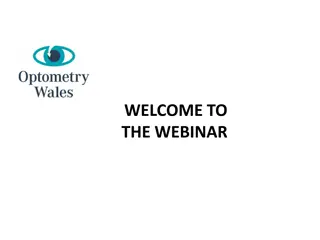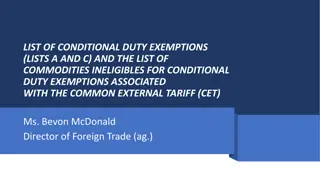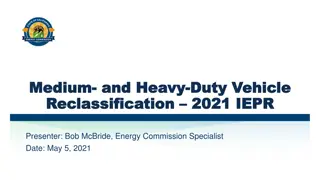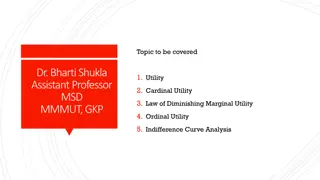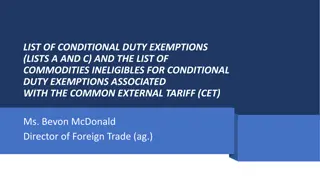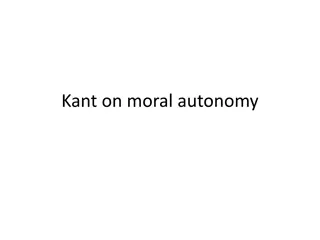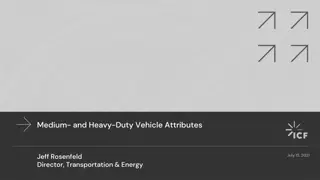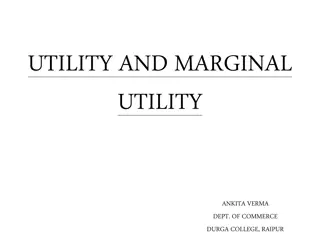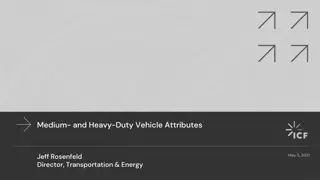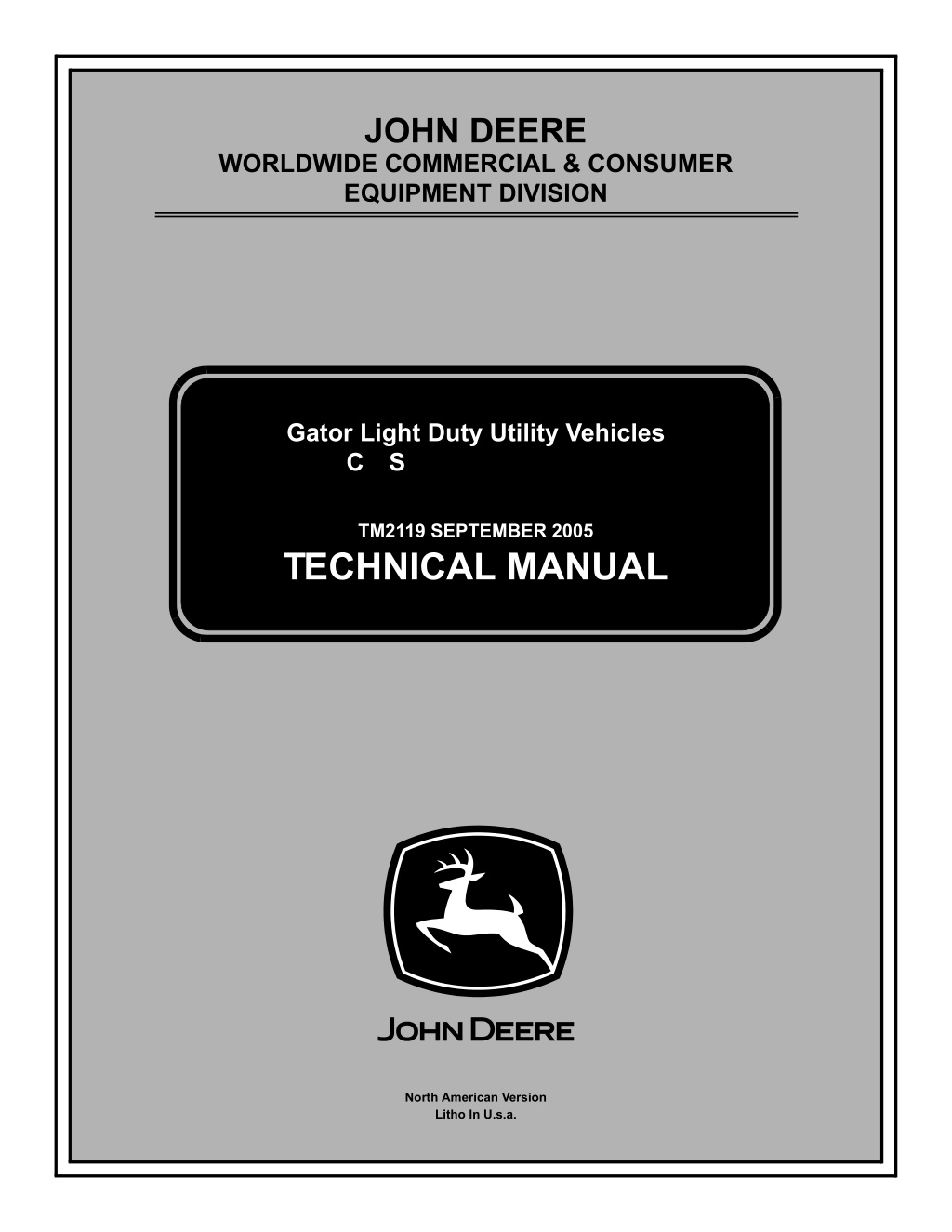
John Deere Gator Light Duty CS CX Utility Vehicle Service Repair Manual Instant Download (TM2119)
Please open the website below to get the complete manualnn//
Download Presentation

Please find below an Image/Link to download the presentation.
The content on the website is provided AS IS for your information and personal use only. It may not be sold, licensed, or shared on other websites without obtaining consent from the author. Download presentation by click this link. If you encounter any issues during the download, it is possible that the publisher has removed the file from their server.
E N D
Presentation Transcript
JOHN DEERE WORLDWIDE COMMERCIAL & CONSUMER EQUIPMENT DIVISION Gator Light Duty Utility Vehicles C S September 2005 TM2119 SEPTEMBER 2005 TECHNICAL MANUAL North American Version Litho In U.s.a.
INTRODUCTION Manual Description Safety This technical manual is written for an experienced technician and contains sections that are specifically for this product. It is a part of a total product support program. Specifications and Information The manual is organized so that all the information on a particular system is kept together. The order of grouping is as follows: Engine (FE250D) Table of Contents Specifications and Information Identification Numbers Engine (FE290D) Tools and Materials Component Location Schematics and Harnesses Electrical Theory of Operation Operation and Diagnostics Power Train Diagnostics Tests and Adjustments Repair Steering Other Note: Depending on the particular section or system being covered, not all of the above groups may be used. Brakes The bleed tabs for the pages of each section will align with the sections listed on this page. Page numbering is consecutive from the beginning of the Safety section through the last section. Miscellaneous We appreciate your input on this manual. If you find any errors or want to comment on the layout of the manual please contact us. All information, illustrations and specifications in this manual are based on the latest information at the time of publication. The right is reserved to make changes at any time without notice. COPYRIGHT 2005 Deere & Co. John Deere Worldwide Commercial and Consumer Equipment Division All rights reserved Previous Editions COPYRIGHT 2003, 2004 Introduction
SAFETY Handle Fluids Safely - Avoid Fires Safety Be Prepared For Emergencies Recognize Safety Information MIF This is the safety-alert symbol. When you see this symbol on your machine or in this manual, be alert to the potential for personal injury. Follow recommended precautions and safe servicing practices. MIF Understand Signal Words heaters or other fire hazards. When you work around fuel, do not smoke or work near A signal word - DANGER, WARNING, or CAUTION - is used with the safety-alert symbol. DANGER identifies the most serious hazards. incinerate or puncture pressurized containers. Store flammable fluids away from fire hazards. Do not DANGER or WARNING safety signs are located near specific hazards. General precautions are listed on CAUTION safety signs. CAUTION also calls attention to safety messages in this manual. debris. Make sure machine is clean of trash, grease, and spontaneously. Do not store oily rags; they can ignite and burn Be prepared if a fire starts. Replace Safety Signs Keep a first aid kit and fire extinguisher handy. service, hospital, and fire department near your telephone. Keep emergency numbers for doctors, ambulance Use Care In Handling and Servicing Batteries MIF Replace missing or damaged safety signs. See the machine operator s manual for correct safety sign placement. MIF Safety - 1
https://www.ebooklibonline.com Hello dear friend! Thank you very much for reading. Enter the link into your browser. The full manual is available for immediate download. https://www.ebooklibonline.com
SAFETY Prevent Battery Explosions such as earmuffs or earplugs to protect against objectionable or uncomfortable loud noises. from the top of battery. Battery gas can explode. Keep sparks, lighted matches, and open flame away Operating equipment safely requires the full attention of the operator. Do not wear radio or music headphones while operating machine. across the posts. Use a volt-meter or hydrometer. Never check battery charge by placing a metal object battery to 16 C (60 F). Do not charge a frozen battery; it may explode. Warm Use Care Around High-pressure Fluid Lines Avoid High-Pressure Fluids Prevent Acid Burns strong enough to burn skin, eat holes in clothing, and cause blindness if splashed into eyes. Sulfuric acid in battery electrolyte is poisonous. It is Avoid acid burns by: 1. Filling batteries in a well-ventilated area. 2. Wearing eye protection and rubber gloves. MIF 3. Avoiding breathing fumes when electrolyte is added. Escaping fluid under pressure can penetrate the skin causing serious injury. 4. Avoiding spilling or dripping electrolyte. 5. Use proper jump start procedure. Avoid injury from escaping fluid under pressure by stopping the engine and relieving pressure in the system before disconnecting or connecting hydraulic or other lines. Tighten all connections before applying pressure. If you spill acid on yourself: 1. Flush your skin with water. 2. Apply baking soda or lime to help neutralize the acid. Search for leaks with a piece of cardboard. Protect hands and body from high pressure fluids. 3. Flush your eyes with water for 10 - 15 minutes. 4. Get medical attention immediately. If an accident occurs, see a doctor immediately. Any fluid injected into the skin must be surgically removed within a few hours or gangrene may result. Doctors unfamiliar with this type of injury should reference a knowledgeable medical source. Such information is available from Deere & Company Medical Department in Moline, Illinois, U.S.A. If acid is swallowed: 1. Drink large amounts of water or milk. 2. Then drink milk of magnesia, beaten eggs, or vegetable oil. Avoid Heating Near Pressurized Fluid Lines 3. Get medical attention immediately. Wear Protective Clothing MIF MIF Flammable spray can be generated by heating near pressurized fluid lines, resulting in severe burns to yourself and bystanders. Do not heat by welding, soldering, or using a torch near pressurized fluid lines or other flammable materials. Pressurized lines can be accidentally cut when heat goes beyond the immediate flame area. Wear close fitting clothing and safety equipment appropriate to the job. Prolonged exposure to loud noise can cause impairment or loss of hearing. Wear a suitable hearing protective device Safety - 2
SAFETY Service Machines Safely Support Machine Properly and Use Proper Lifting Equipment MIF Tie long hair behind your head. Do not wear a necktie, scarf, loose clothing, or necklace when you work near machine tools or moving parts. If these items were to get caught, severe injury could result. MIF If you must work on a lifted machine or attachment, securely support the machine or attachment. Remove rings and other jewelry to prevent electrical shorts and entanglement in moving parts. Do not support the machine on cinder blocks, hollow tiles, or props that may crumble under continuous load. Do not work under a machine that is supported solely by a jack. Follow recommended procedures in this manual. Use Proper Tools Use tools appropriate to the work. Makeshift tools and procedures can create safety hazards. Use power tools only to loosen threaded parts and fasteners. For loosening and tightening hardware, use the correct size tools. DO NOT use U.S. measurement tools on metric fasteners. Avoid bodily injury caused by slipping wrenches. Use only service parts meeting John Deere specifications. Lifting heavy components incorrectly can cause severe injury or machine damage. Follow recommended procedure for removal and installation of components in the manual. Work In Clean Area Before starting a job: Parking Safely 1. Clean work area and machine. 2. Make sure you have all necessary tools to do your job. 3. Have the right parts on hand. 4. Read all instructions thoroughly; do not attempt shortcuts. Using High Pressure Washers Directing pressurized water at electronic/electrical components or connectors, bearings, hydraulic seals, fuel injection pumps or other sensitive parts and components may cause product malfunctions. Reduce pressure and spray at a 45 to 90 degree angle. MIF 1. Stop machine on a level surface, not on a slope. 2. Disengage and stop attachments. 3. Lower attachments to the ground. Illuminate Work Area Safely 4. Lock park brake. Illuminate your work area adequately but safely. Use a portable safety light for working inside or under the machine. Make sure the bulb is enclosed by a wire cage. The hot filament of an accidentally broken bulb can ignite spilled fuel or oil. 5. Stop engine. 6. Remove key. 7. Wait for engine and all moving parts to stop before you leave the operator s station. 8. Close fuel shut-off valve, if your machine is equipped. Safety - 3
SAFETY Work In Ventilated Area Avoid creating dust. Never use compressed air for cleaning. Avoid brushing or grinding material containing asbestos. When servicing, wear an approved respirator. A special vacuum cleaner is recommended to clean asbestos. If not available, apply a mist of oil or water on the material containing asbestos. Keep bystanders away from the area. Service Tires Safely MIF Engine exhaust fumes can cause sickness or death. If it is necessary to run an engine in an enclosed area, remove the exhaust fumes from the area with an exhaust pipe extension. If you do not have an exhaust pipe extension, open the doors and get outside air into the area. MIF Warning: California Proposition 65 Warning Explosive separation of a tire and rim parts can cause serious injury or death. Gasoline engine exhaust from this product contains chemicals known to the State of California to cause cancer, birth defects, or other reproductive harm. Do not attempt to mount a tire unless you have the proper equipment and experience to perform the job. Diesel engine exhaust and some of its constituents are known to the State of California to cause cancer, birth defects, and other reproductive harm. Always maintain the correct tire pressure. Do not inflate the tires above the recommended pressure. Never weld or heat a wheel and tire assembly. The heat can cause an increase in air pressure resulting in a tire explosion. Welding can structurally weaken or deform the wheel. Remove Paint Before Welding or Heating When inflating tires, use a clip-on chuck and extension hose long enough to allow you to stand to one side and NOT in front of or over the tire assembly. Use a safety cage if available. Avoid potentially toxic fumes and dust. Hazardous fumes can be generated when paint is heated by welding, soldering, or using a torch. Do all work outside or in a well ventilated area. Dispose of paint and solvent properly. Remove paint before welding or heating: If you sand or grind paint, avoid breathing the dust. Wear an approved respirator. If you use solvent or paint stripper, remove stripper with soap and water before welding. Remove solvent or paint stripper containers and other flammable material from area. Allow fumes to disperse at least 15 minutes before welding or heating. Check wheels for low pressure, cuts, bubbles, damaged rims or missing lug bolts and nuts. Avoid Harmful Asbestos Dust Avoid breathing dust that may be generated when handling components containing asbestos fibers. Inhaled asbestos fibers may cause lung cancer. Components in products that may contain asbestos fibers are brake pads, brake band and lining assemblies, clutch plates, and some gaskets. The asbestos used in these components is usually found in a resin or sealed in some way. Normal handling is not hazardous as long as airborne dust containing asbestos is not generated. Safety - 4
SAFETY Avoid Injury From Rotating Blades, Augers and PTO Shafts Dispose of Waste Properly Improperly disposing of waste can threaten the environment and ecology. Potentially harmful waste used with John Deere equipment include such items as oil, fuel, coolant, brake fluid, filters, and batteries. Use leakproof containers when draining fluids. Do not use food or beverage containers that may mislead someone into drinking from them. Do not pour waste onto the ground, down a drain, or into any water source. Inquire on the proper way to recycle or dispose of waste from your local environmental or recycling center, or from your John Deere dealer. Live With Safety MIF Keep hands and feet away while machine is running. Shut off power to service, lubricate or remove mower blades, augers or PTO shafts. Handle Chemical Products Safely MIF Before returning machine to customer, make sure machine is functioning properly, especially the safety systems. Install all guards and shields. MIF Direct exposure to hazardous chemicals can cause serious injury. Potentially hazardous chemicals used with John Deere equipment include such items as lubricants, coolants, paints, and adhesives. A Material Safety Data Sheet (MSDS) provides specific details on chemical products: physical and health hazards, safety procedures, and emergency response techniques. Check the MSDS before you start any job using a hazardous chemical. That way you will know exactly what the risks are and how to do the job safely. Then follow procedures and recommended equipment. Safety - 5
POWER TRAIN - GEAR DIAGNOSTICS Diagnostics Engine Drive Clutch Check Diagnostic Check Points Test Conditions set Engine running at operating temperature and brakes Drive Train Diagnostics Transmission in neutral position Test Conditions appropriate engine specifications. Ensure engine is at correct slow idle speed. See Engine OFF Rear wheels supported off floor Engine Drive Clutch same radius. Air pressure equal in driving tires. Driving tires close to 1. Drive clutch disengaged (drive belt not moving)? Yes: Go to next step. Drive Train No: Repair or replace drive clutch. See Drive Clutch Repair on page 265. 1. Is the drive belt in good condition? Yes: Go to next step. Engine Drive Clutch Check No: Replace drive belt. 2. Shift linkage shifts in to forward, neutral and reverse and stays in gear during operation? Test Conditions set Engine running at operating temperature and brakes Yes: Go to next step. No: Adjust shift linkage. See Transaxle Shift Adjustment on page 262. Transmission in NEUTRAL Accelerate engine 3. Axles rotate smoothly and quietly; no free play in axles, bearings or housings? Engine Drive Clutch Yes: Go to next step. 1. Drive clutch engages drive belt at 1350 - 1600 rpm? No: Check axles and housings. Yes: Go to next step. 4. Brakes not dragging? No: Replace drive belt. Repair or replace drive clutch. See Drive Clutch Repair on page 265. Yes: Go to next step. No: Adjust brakes. See Brake Spring Adjustment on page 307 in the Brakes section. Drive Clutch and Driven Clutch Check 5. Differential lock engages and disengages? Test Conditions Yes: Go to next step. set Engine running at operating temperature and brakes No: Adjust differential lock. See Differential Lock Cable Adjustment (CX Only) on page 263. Transmission in NEUTRAL 6. Differential lock produces no ratcheting sound in transaxle? appropriate engine specifications. Ensure engine is at correct fast idle speed. See Yes: Go to next step. Drive and Driven Clutch No: Check internal components. 1. Drive clutch sheave (movable clutch sheave) moves toward stationary sheave? Yes: Go to next step. No: Repair or replace drive clutch. See Drive Clutch Repair on page 265. 2. Driven clutch sheaves separate? Yes: Go to next step. No: Repair or replace driven clutch. Power Train - Gear Diagnostics - 261
POWER TRAIN - GEAR TESTS AND ADJUSTMENTS Tests and Adjustments 3. Driven clutch fully up-shifted, drive clutch sheaves completely close? Transaxle Shift Adjustment No: Repair or replace drive and/or driven clutches. See Drive Clutch Repair on page 265. Reason: transaxle is in neutral. To insure gear shift lever is centered in neutral when completely engaged. To insure both forward and reverse gears will be during operation. To help prevent shifter from disengaging from gear Procedure: 1. Park on level surface and lock park brake. Cargo box raised, engine off, key removed. 2. Move shift lever until detent inside transaxle clicks firmly into the center neutral position. A MX30629 3. Loosen shift rod nuts (A) as necessary. Adjust the shift rod nuts so the shift lever is centered in the shifter quadrant in the neutral position. 4. Shift into forward and reverse. There should be an even gap between the lever and quadrant in both forward and reverse positions. The shift lever should NOT contact the shift quadrant in either forward or reverse. Adjust the shift linkage if the gaps are uneven. Tighten the shift rod nuts. 5. Shift into neutral. Check neutral start. 6. Drive machine over rough ground to check adjustments. Power Train - Gear Tests and Adjustments - 262
POWER TRAIN - GEAR TESTS AND ADJUSTMENTS Differential Lock Cable Adjustment (CX Only) will still not disengage transaxle, check that differential lock spring (C) has tension. If cable is adjusted correctly and lock lever movement Reason: To insure complete disengagement and engagement of differential lock. Conditions: Engine OFF Conditions: Park brake OFF Engine OFF Cargo box RAISED Park brake OFF Differential lock lever ENGAGED Cargo box RAISED Engagement Check: Differential lock lever DISENGAGED 1. Engage differential lock lever at operator s station. Right rear side wheel jacked up and free to rotate 2. Move differential lock arm at transaxle by hand. Check for free play. Left side of machine wheels on ground and chocked 3. Remove free play by adjusting cable. Disengagement Check: 1. By hand, rotate right side drive wheel. Results: rotated. When locked, tire should not rotate. If differential will not lock, adjust cable. Differential lock should engage, or engage as tire is Results: transaxle. Wheel should rotate freely with no clicking sound in Differential should be disengaged. Drive Train Performance Tests Engagement and Full Up-Shift Check c Caution: Avoid Injury! When operating machine to observe drive train performance, always operate in an area flat and free of obstacles. Use a passenger to observe power train so you can concentrate on driving safely. Never back machine with cargo box raised. C B A Reason: To determine if the engine and drive train are operating at peak performance. Conditions: MX30379 Engine slow idle and fast idle speed set correctly differential lock cable rear adjusting nuts (A), and slacken cable: If there is noise or wheel will not rotate, loosen Drive belt width at or above minimum specification Engine warmed up Note: If brakes are too tight, wheel will be difficult to rotate. See Inspecting Brake Cables and Brake Function on page 306. Procedure: 1. Transaxle in neutral, park brake set. Start engine. 2. Slowly increase engine rpm. Observe engine rpm when clutch starts to engage and move drive belt. If differential releases, check cable adjustment. arm on transaxle by hand while trying to rotate tires and check if differential lock shaft is moving freely. If not, repair transaxle. If differential will not release, move differential lock Power Train - Gear Tests and Adjustments - 263
POWER TRAIN - GEAR TESTS AND ADJUSTMENTS Driven Clutch Back-Shifting Check Reason: A To determine condition of driven clutch and back-shifting performance. B Conditions: MX0763 3. Accelerate from idle to wide-open-throttle and back to idle several times. Watch drive belt for a smooth transition from bottom to top of drive clutch (A). Watch closely for any hesitation or engine surging. Observe gap between drive clutch movable sheave and stationary sheave. Gap should close completely (B). MX0764 4. When approaching idle, watch for a positive disengagement from drive belt. Cargo box raised supported safely on jack-stands. Indoor testing - rear wheels off ground and machine Note: On clutches with some hours of use, system may not disengage as smoothly due to the drive clutch spring taking a set and wear in the drive components. Front wheels chocked Differential lock engaged if equipped 5. Shut off engine. Tachometer displaying engine speed Result: Procedure: c Caution: Avoid Injury! Rear wheels will rotate during test. Keep clear! 1. Start engine. 2. Put transaxle in gear. C 3. Operate engine at wide open throttle. MX0764 Results: between 1350 - 1600 rpm. Drive belt should be riding high in drive clutch and low in driven clutch (C). Clutch should slowly start to engage and move drive belt speed. Drive belt should be riding high in drive clutch and low in driven clutch. Engine and wheel speed should remain at constant hesitation, or clutch noise (chirping), perform drive clutch lubrication. Check drive clutch for cam weights binding, pivot pins worn, flat spots on rollers or rollers sticking, and no groove in sheave. Repair or replace drive clutch. If clutch has harsh engagement, erratic transition, Procedure: 1. Momentarily load power train by slowly applying brake or park brake until back-shift is made. performance. If engine is surging; check engine and governor 2. Quickly observe engine speed, then release brake. Results: clutch is good. Go to Driven Clutch Back-Shifting Check . Smooth engagement and transition (up-shift), drive Clutches should back-shift as load is increased. Drive belt should not squeal or slip. on drive train, such as an engaged brake or failed axle bearings. See Brake Spring Adjustment on page 307 in the Brakes section. Check driven clutch for complete up-shift. Check for load Power Train - Gear Tests and Adjustments - 264
POWER TRAIN - GEAR REPAIR Repair Drive Clutch Repair Special or Required Tools: Drive Clutch Removal and Installation JDG813 Clutch Servicing Kit 1. Park machine safely. Procedure: 2. Raise cargo box. 1. Remove clutch cover bolts. Remove cover. (Cover should pop off; do not pry). A MX31622 3. Remove plug (A) in front of left rear wheel. A 4. Remove drive belt guard and drive belt. 5. Remove plastic plug from left side of clutch cover. 6. Remove clutch mounting bolt and washers. B M58704 MX35411b 7. Use JDG1641 Clutch Removal Tool (B). Thread the puller into the clutch and against crankshaft. Tighten until clutch pops free from the crankshaft. 2. Install JDG813-3 Tapered Holding Tool (B) to the clutch. Retain it with an M10 X 1.5 X 150 mm socket-head bolt. Place the clutch and tool securely into a vise as shown. Note: Use an impact wrench to remove the drive clutch. Important: Avoid Damage! Use spanner wrench to remove spider. Unequal pressure on clutch towers could cause stress fractures or break them off. Use medium strength thread lock on spider threads when installing. 8. Install clutch in reverse order of removal. Tighten clutch bolt to specification. Torque Specification: Clutch Bolt . . . . . . . . . . . . . . . . . . . . . . 37 N m (28 lb-ft) Power Train - Gear Repair - 265
POWER TRAIN - GEAR REPAIR B- Spring C- Stationary Sheave D- Washer E- Clutch Sheave F- Pivot Bolt (3 used) G- Cam Weight (3 used) H- O-Ring (6 used) I- Roller (3 used) J- Thrust Washers (3 used) K- Button (6 used) L- Pin (3 used) M- Plastic Thrust Washers (6 used) B C 1. Check spider rollers for flat spots or binding. 2. Reassemble components. Tighten spider to 135 N m (100 lb-ft). Use medium strength thread lock on threads. MX35411a Driven Clutch Ramp Shoe Replacement 3. Use a 1/2 in. drive tool (B) andJDG813-2 Spanner Wrench (C) to remove spider. 1. Park machine safely. 2. Raise or remove cargo box. Inspection: 3. Remove engine access panel. Note: Each side of the cam weight (G) has plastic thrust washers (M). B A C D A B A L H MX30495 4. Remove cap screws (A) and belt guard (B). C H E J K G F I M F MX30508 M56707 and MX1402 A- Spider 5. Check for missing or worn clutch buttons (C). Power Train - Gear Repair - 266
POWER TRAIN - GEAR REPAIR metal contact. There should not be excessive wear, or metal-to- G If replacement is necessary, continue with procedure. 6. Remove drive belt. 7. Install locking pliers on outer edge of fixed sheave half. Rotate sheave until pliers contact frame and prevent sheave from turning. E F C 8. Turn moveable sheave until shoes are away from ramps. Install small block of wood between other ramps and shoes to hold sheave in position. 9. Remove ramp shoe. 10.Install new ramp shoes. Push ramp shoe straight in with a screwdriver by prying against cam. D necessary. If shoe is difficult to install, sand mounting tab as MX30379 (medium strength) on mounting tabs. If shoe is loose, apply thread lock and sealer 5. Remove two nuts (C) securing rear of transaxle skid pan. Remove skid pan. 11.Install belt guard. Tighten cap screws to 14 N m (124 lb- in.). Note: Differential lock assembly used on CX Gators only. 12.Install engine access panel. 6. Loosen lock nut (D) securing differential lock control cable to transaxle housing. Lift cable from transaxle housing and rotate cable until it can be removed through slot in transaxle differential lock lever (E). 13.Lower the cargo box. Transaxle Removal and Installation 7. Disconnect wiring harness connector (F) from neutral switch. Removal (SN -M000CXA040000): 1. Park machine safely. Note: Remove the muffler to obtain the clearance to remove the shift lever from transaxle. 2. Block front wheels. 3. Remove cargo box. 8. Loosen lock nut (G) securing shift lever to shifter shaft. H J I A B MX30380 4. Remove three nuts (A) and cap screws securing front of transaxle skid pan (B). MX30381 9. Unlock parking brake. Remove cotter pin (H) from drilled pin in brake rod clevis (I). Remove drilled pin and disconnect clevis from brake lever. 10.Repeat for other side. Power Train - Gear Repair - 267
POWER TRAIN - GEAR REPAIR 11.Loosen nut (J) on transaxle front mounting bolt. A B K MX35178 Picture Note: Components removed for clarity. MX30382 4. Remove nuts and cap screws (A) securing the transaxle skid pan (B). Remove skid pan. 12.Remove two nuts (K) from axle-to-frame mounting bolts. 13.Repeat for other side. C Important: Avoid Damage! As machine frame is raised, remove shift lever from transaxle shifter shaft. 14.Place jack under frame in front of rear wheels and slowly raise machine. Remove shift lever from shifter shaft. Continue to raise machine until transaxle and wheels assembly can be rolled out from under machine. Important: Avoid Damage! Support front of transaxle while removing front mounting bolt. 15.Remove nut (J) and transaxle front mounting bolt. D 16.Remove transaxle assembly from under machine. MX30629 Removal (SN M00CXRA040001-): 5. Loosen nut and cap screw (C) securing the shift lever to the transaxle. Remove shift lever from transaxle. 1. Remove cargo box. See Cargo Box Removal and Installation on page 316. 6. Loosen lock nut (D) securing differential lock control cable to transaxle housing. Lift cable from transaxle housing and rotate cable until it can be removed through slot in transaxle differential lock lever. 2. Block front wheels. Raise and safely support the rear of the machine. 3. Remove the exhaust pipe and muffler. See Muffler Removal and Installation on page 85. Power Train - Gear Repair - 268
POWER TRAIN - GEAR REPAIR page 263. Torque Specifications: Transaxle Mounting Bolts . . . . . . . . . . 120 N m (90 lb-ft) Shift Lever to Transaxle Shift Shaft Bolt 50 N m (37 lb- ft) F G E Transaxle Disassembly and Assembly Transaxles are available with and without a differential lock. Except for the differential lock components, the transaxles are the same. Transaxle disassembly and assembly are shown with the differential lock installed. Differential lock parts are noted. MX30381 Axle Removal: 7. Disconnect wiring harness connector from neutral switch (E). 1. Drain transaxle. 8. Unlock parking brake (if set). Remove cotter pin (F) from drilled pin in brake rod clevis (G). Remove drilled pin from clevis. Disconnect clevis from brake lever. A 9. Repeat for other side. H B MX30386 2. Remove differential lock spring (A) if equipped. I 3. Remove cap screws (B) securing right axle housing to transaxle case. MX35239 10.Remove front transaxle bolt (I). Note: When separating axle assembly from transaxle housing three ball bearings from brake assembly may fall out. 11.Remove the transaxle mounting bolts (H) from each side of the machine. 4. Carefully separate axle assembly from transaxle housing. 12.Remove transaxle from under machine. Installation: Installation is the reverse of removal. Tighten bolts and nuts to specification. Adjustment on page 307 in the Brakes section. Adjust brakes if necessary. See Brake Spring Transaxle Shift Adjustment on page 262. Adjust transaxle shift linkage if necessary. See Differential Lock Cable Adjustment (CX Only) on Adjust differential lock cable if necessary. See Power Train - Gear Repair - 269
POWER TRAIN - GEAR REPAIR G C F F MX30388 D 10.Remove snap ring (G), washer and axle collar from axle. Important: Avoid Damage! Remove axle from axle housing by driving it toward the transaxle flange end of housing. Do not remove axle from small end of housing. MX30387 Picture Note: Brake ball bearings shown in position for reference. 5. Remove differential lock collar (C) if equipped. 11.Drive axle from axle housing. 6. Remove brake actuator ring (D). 12.Remove axle seal from housing. E H MX30390 MX30389 7. Remove snap ring (E) and washer securing brake cam lever. Remove cam lever from housing. Replace cam lever O-ring before assembly. 13.Remove snap ring (H) and bearing from housing. 14.Inspect bearing for damage. Replace if necessary. 15.Replace seal before assembly. 8. Remove two cap screws and ring retainers (F) holding brake plates in axle housing. Transaxle Disassembly: 9. Remove brake plates. 1. Remove axles. See Axle Removal: on page 269. Power Train - Gear Repair - 270
POWER TRAIN - GEAR REPAIR A B E D MX30391 2. Remove cap screw and shifter shaft lock plate (A). MX30393 3. Remove flange bolt (B), washer, spring and detent ball bearing from transaxle housing. 6. Remove shifter fork (D) and gear shift assembly (E). Note: Raise shifter shaft during housing separation to disengage shift lever from shift collar. F G 4. Remove cap screws securing transaxle case halves. Carefully separate case halves. C MX30394 7. Remove input shaft (F) and reverse shaft (G) assemblies. MX30392 H 5. Loosen gear assemblies from case. Remove differential assembly (C). For deferential disassembly see Differential: on page 274. I MX30395 8. Remove snap ring (H) and replace input shaft seal (I). Power Train - Gear Repair - 271
Suggest: If the above button click is invalid. Please download this document first, and then click the above link to download the complete manual. Thank you so much for reading
POWER TRAIN - GEAR REPAIR Differential Shift Assembly: Forward/Reverse Reduction Gear: Important: Avoid Damage! When removing spring pin, avoid damage to transaxle case. A B A MX30399 1. Remove ball bearing (A) from gear assembly. Note: The thrust washers have three different inside diameters. Note location during disassembly. MX30396 C 1. Remove spring pin (A) from differential lock shifter. 2. Slide differential lock shaft assembly (B) out of case. B C MX30400 2. Remove thrust washer (B) and gear (C). MX30397 3. Remove and replace seal (C). E D MX30401 3. Remove thrust washer (D) and shift collar (E). Power Train - Gear Repair - 272
https://www.ebooklibonline.com Hello dear friend! Thank you very much for reading. Enter the link into your browser. The full manual is available for immediate download. https://www.ebooklibonline.com

